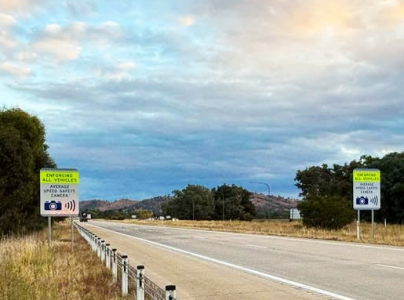Hate demerit points? You’ll want to read this warning letter update
By
Maan
- Replies 0
Speeding fines are never a welcome surprise—but what if that ominous-looking envelope in the mail didn’t bring a penalty, just a peculiar kind of warning?
A new approach to road safety enforcement in NSW is leaving many Australians scratching their heads.
Here’s what you need to know about the unexpected letters showing up in mailboxes across the state.
When a letter arrived in the post from Revenue NSW, it didn’t spark the kind of dread one might expect.
At first, it actually sparked a laugh.
The envelope looked official—serious enough to make anyone flinch—but what was inside wasn’t the fine or licence-threatening notice many brace themselves for. It wasn’t even a slap on the wrist.
It was more like a polite tap on the shoulder.
The confusion didn’t stop there.
‘But did you get fined?’
That was the main question the writer kept getting when they mentioned the letter to others.
And that’s the thing—these letters don’t come with a fine, don’t dock demerit points, and won’t affect your licence. Instead, they serve as a subtle heads-up from the government: ‘Hey, you were speeding, so ease up.’
It’s this unfamiliarity that seems to unsettle drivers. For some, it’s enough to jolt them into caution. Others are sceptical about how effective these letters really are in changing behaviour over time.
‘Honestly, this would deter me, I think it’s the people pleaser in me,’ a colleague admitted.
A friend had a more vivid take: ‘If I stumble next to a cliff I’m not going to keep walking next to the cliff, so I won’t speed again in that area. But I doubt it’ll stop people speeding elsewhere.’
And then there are those flashing digital signs with the sad face emoji—those guilt trips tend to work better, at least according to the writer.
‘These little signs make me slow down way more than a letter in the mail ever could.’
But these letters are more than just red tape. They’re part of a system, carefully designed to prepare drivers for upcoming changes on the road.
When a new speed camera was installed—like at the Rozelle Interchange in Sydney’s Inner West earlier this year—warning letters were issued first instead of instant fines.
Think of it as a soft launch.
Drivers were given time to adjust to the presence of the cameras, especially with the potential for high-speed travel in the area.
The rollout began on 6 March 2024, and the warning phase continued through June.
By June’s end, three out of four average speed cameras were switched to full enforcement mode, issuing fines and demerit points. One camera remained in the warning stage.
So, if a warning letter arrived from Rozelle, the recipient could consider themselves fortunate.
Elsewhere in NSW, average speed cameras have been active for some time—initially used for heavy vehicles like trucks and buses. But trials were underway to evaluate their effectiveness on lighter vehicles too.
Two locations currently in focus:
A warning phase ran from 1 May to 30 June 2025, before enforcement was scheduled to begin on 1 July.
It’s not unlike being let off with a warning by a cop after slowing down post-hill—the difference being, this is just a formal version in your mailbox.
So how do average speed cameras actually work?
Unlike single-point speed cameras, these ones calculate a vehicle’s average speed between two fixed points. Drivers can’t just hit the brakes right before passing—they’re monitored over distance.
But even during warning phases, not everything gets a free pass.
If someone exceeded the limit by more than 30 km/h, fines and demerit points still applied. For anything under that threshold, only a warning letter was issued.
‘That is more than fair. I think 20 over you should get fined,’ another colleague remarked.
The same 30 km/h rule applied across NSW, whether it involved fixed, mobile, or point-to-point speed cameras.
Despite the buzz, this approach wasn’t new.
NSW had been sending out warning letters since the early 2000s, and the policy had stayed in place for over a decade.
Ms Sally Webb, Deputy Secretary for Safety, Policy, Environment and Regulation, said.
‘Speeding is one of the biggest killers on NSW roads and camera enforcement is one of the most effective, evidence-based measures to reduce speeding.
‘When a fixed speed camera, red-light speed camera or average speed camera is installed, it is clearly signposted, a media release is issued to the local community and Transport for NSW implements a warning period to help drivers adjust their driving behaviour. The policy of issuing warning letters has been in place for more than ten years.’
She added: ‘During warning mode the cameras are monitored for levels of compliance, once a certain level of compliance is achieved cameras are switched to enforcement mode.’
‘Drivers are reminded that they should always comply with the speed limits, not just when they know there is a speed camera. It’s the law and it saves lives—travelling at 65 km/h in a 60km/h limit doubles the risk of a casualty crash.’
So while a warning letter might feel like a lucky break, it’s also a not-so-gentle nudge to drive safer—before it starts costing more than just your time.
It’s not every day a driver avoids a speeding fine with a story that sounds straight out of the bush.
But when nature gets involved, even the law sometimes takes a back seat.
If you’ve ever had a wild moment behind the wheel, this one’s worth a watch.
Source: Youtube/7NEWS Australia

Have you ever received a warning instead of a fine—and did it actually make you slow down for good? Let us know your thoughts in the comments.
In a previous story, we looked at a new road safety trial aimed at curbing speeding as road fatalities continue to rise—a concern that hits close to home for many older Australians who’ve seen the toll unsafe driving can take over the years.
With warning letters now part of the mix, it’s clear authorities are trying different approaches to keep drivers in check.
If you’re curious about how these trials fit into the bigger picture, that’s one worth reading too.
Read more: New road safety trial targets speeding drivers as fatalities rise
A new approach to road safety enforcement in NSW is leaving many Australians scratching their heads.
Here’s what you need to know about the unexpected letters showing up in mailboxes across the state.
When a letter arrived in the post from Revenue NSW, it didn’t spark the kind of dread one might expect.
At first, it actually sparked a laugh.
The envelope looked official—serious enough to make anyone flinch—but what was inside wasn’t the fine or licence-threatening notice many brace themselves for. It wasn’t even a slap on the wrist.
It was more like a polite tap on the shoulder.
The confusion didn’t stop there.
‘But did you get fined?’
That was the main question the writer kept getting when they mentioned the letter to others.
And that’s the thing—these letters don’t come with a fine, don’t dock demerit points, and won’t affect your licence. Instead, they serve as a subtle heads-up from the government: ‘Hey, you were speeding, so ease up.’
It’s this unfamiliarity that seems to unsettle drivers. For some, it’s enough to jolt them into caution. Others are sceptical about how effective these letters really are in changing behaviour over time.
‘Honestly, this would deter me, I think it’s the people pleaser in me,’ a colleague admitted.
A friend had a more vivid take: ‘If I stumble next to a cliff I’m not going to keep walking next to the cliff, so I won’t speed again in that area. But I doubt it’ll stop people speeding elsewhere.’
And then there are those flashing digital signs with the sad face emoji—those guilt trips tend to work better, at least according to the writer.
‘These little signs make me slow down way more than a letter in the mail ever could.’
But these letters are more than just red tape. They’re part of a system, carefully designed to prepare drivers for upcoming changes on the road.
When a new speed camera was installed—like at the Rozelle Interchange in Sydney’s Inner West earlier this year—warning letters were issued first instead of instant fines.
Think of it as a soft launch.
Drivers were given time to adjust to the presence of the cameras, especially with the potential for high-speed travel in the area.
The rollout began on 6 March 2024, and the warning phase continued through June.
By June’s end, three out of four average speed cameras were switched to full enforcement mode, issuing fines and demerit points. One camera remained in the warning stage.
So, if a warning letter arrived from Rozelle, the recipient could consider themselves fortunate.
Elsewhere in NSW, average speed cameras have been active for some time—initially used for heavy vehicles like trucks and buses. But trials were underway to evaluate their effectiveness on lighter vehicles too.
Two locations currently in focus:
- Pacific Highway from Kew to Lake Innes (15 km)
- Hume Highway from Coolac to Gundagai (16 km)
A warning phase ran from 1 May to 30 June 2025, before enforcement was scheduled to begin on 1 July.
It’s not unlike being let off with a warning by a cop after slowing down post-hill—the difference being, this is just a formal version in your mailbox.
So how do average speed cameras actually work?
Unlike single-point speed cameras, these ones calculate a vehicle’s average speed between two fixed points. Drivers can’t just hit the brakes right before passing—they’re monitored over distance.
But even during warning phases, not everything gets a free pass.
If someone exceeded the limit by more than 30 km/h, fines and demerit points still applied. For anything under that threshold, only a warning letter was issued.
‘That is more than fair. I think 20 over you should get fined,’ another colleague remarked.
The same 30 km/h rule applied across NSW, whether it involved fixed, mobile, or point-to-point speed cameras.
Despite the buzz, this approach wasn’t new.
NSW had been sending out warning letters since the early 2000s, and the policy had stayed in place for over a decade.
Ms Sally Webb, Deputy Secretary for Safety, Policy, Environment and Regulation, said.
‘Speeding is one of the biggest killers on NSW roads and camera enforcement is one of the most effective, evidence-based measures to reduce speeding.
‘When a fixed speed camera, red-light speed camera or average speed camera is installed, it is clearly signposted, a media release is issued to the local community and Transport for NSW implements a warning period to help drivers adjust their driving behaviour. The policy of issuing warning letters has been in place for more than ten years.’
She added: ‘During warning mode the cameras are monitored for levels of compliance, once a certain level of compliance is achieved cameras are switched to enforcement mode.’
‘Drivers are reminded that they should always comply with the speed limits, not just when they know there is a speed camera. It’s the law and it saves lives—travelling at 65 km/h in a 60km/h limit doubles the risk of a casualty crash.’
So while a warning letter might feel like a lucky break, it’s also a not-so-gentle nudge to drive safer—before it starts costing more than just your time.
But when nature gets involved, even the law sometimes takes a back seat.
If you’ve ever had a wild moment behind the wheel, this one’s worth a watch.
Source: Youtube/7NEWS Australia
Key Takeaways
- NSW drivers have been receiving official-looking letters warning them about speeding, but without fines or demerit points.
- These warning letters are part of a phased approach to new speed camera rollouts, giving drivers time to adjust.
- Average speed cameras calculate a car’s speed over distance and only issue warnings unless the driver exceeds the limit by more than 30 km/h.
- The system, in place since the early 2000s, aims to improve road safety before shifting to full enforcement with fines and penalties.
Have you ever received a warning instead of a fine—and did it actually make you slow down for good? Let us know your thoughts in the comments.
In a previous story, we looked at a new road safety trial aimed at curbing speeding as road fatalities continue to rise—a concern that hits close to home for many older Australians who’ve seen the toll unsafe driving can take over the years.
With warning letters now part of the mix, it’s clear authorities are trying different approaches to keep drivers in check.
If you’re curious about how these trials fit into the bigger picture, that’s one worth reading too.
Read more: New road safety trial targets speeding drivers as fatalities rise








